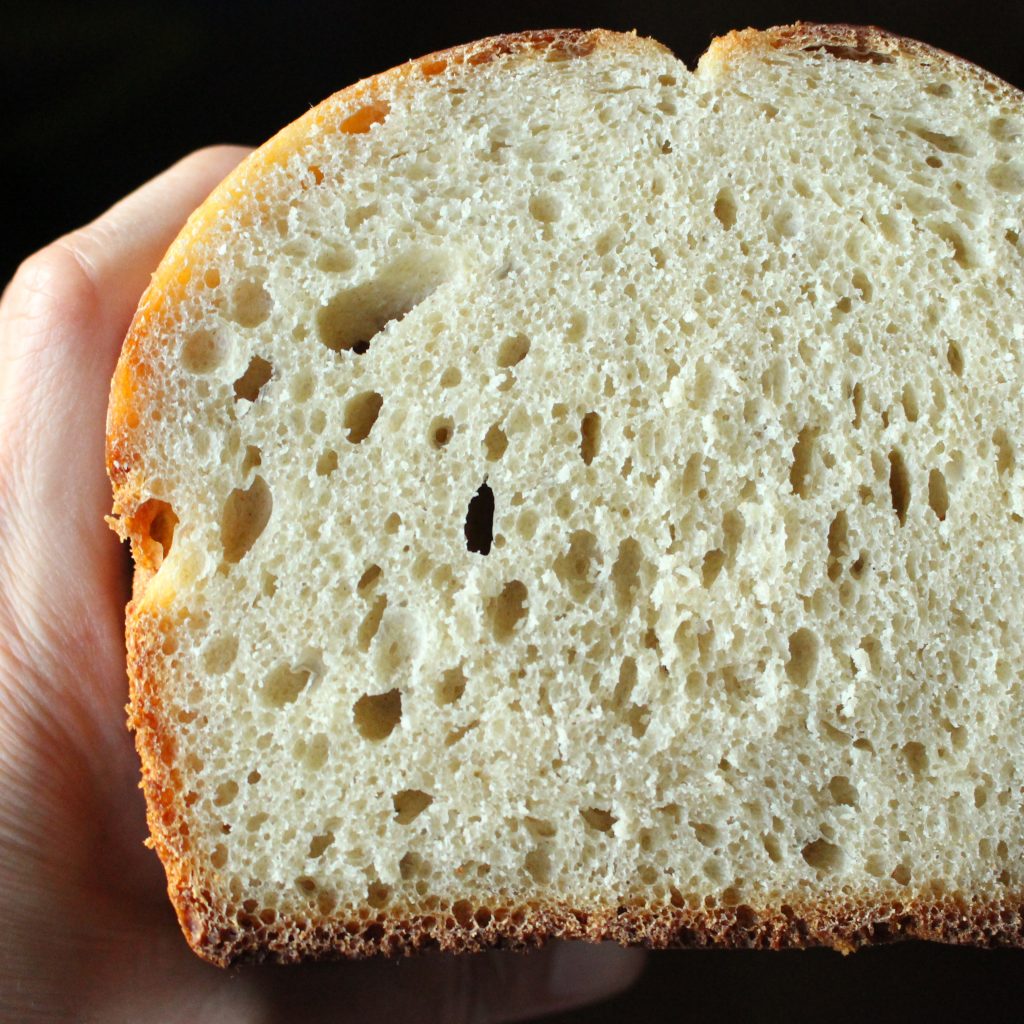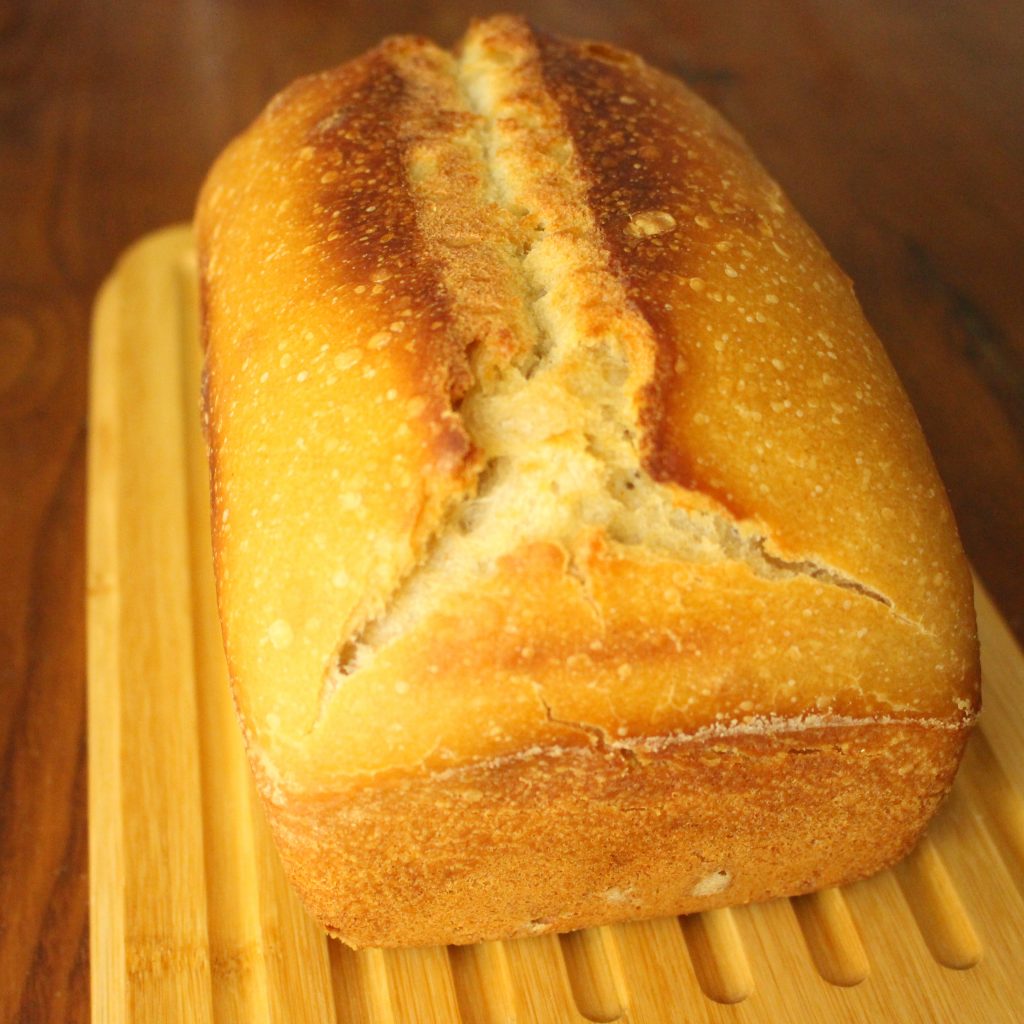There are so many other ways to naturally ferment bread than sourdough. Any form of live culture – yogurt, sauerkraut, beer – is a potential bread-maker! In this recipe, I’ll show you one of my favourite methods; using milk kefir to raise a loaf.

Why I love milk kefir-leavened bread:
A sourdough culture includes both lactic acid (a by-product of lactobacillus) and acetic acid (a by-product of acetobacter). Both of these acids flavour the finished sourdough bread. That’s why sometimes sourdough can be really sour and other times not.
Milk kefir is dominant in lactobacillus. So when you raise a bread using solely milk kefir, the culture is much more lactic acid dominant than sourdough. This lends a creaminess to the resultant loaf is delicious! My recipe also includes a touch of honey, which rounds this nutty spelt flour loaf off beautifully.
Things to note about this bread:
You’ll need *live* milk kefir. You can make this yourself, using fresh milk and milk kefir ‘grains’ or you can purchase it. If you decide to buy it, make sure it states that it contains live bacteria, as without these, you will not be able to create a leaven.
It’s a high hydration bread and will need supporting in a loaf tin during cooking. I use a 1kg ceramic loaf tin with a lid to bake it. You can use any similar sized tin.
To make this loaf – both to raise the leaven and proof the bread, you’ll need a warm place (warmer than a ‘standard’ sourdough set up). Lactobacillus grow best at 28C/84.5F though I have successfully created the leaven at temperatures between 22C/71.5F and 28C/84.5F. In some environments, the bread might need some help – an airing cupboard or warm room. If you need it, click here to have me guide you through how to create a DIY proofing box.
This bread includes a overnight retard in the fridge. In total it takes a day and a half. My usual schedule is below.
Milk Kefir Spelt Bread

Timings:
Day 1 – 1pm – mix leaven
Day 2 – c. 8am – mix dough and set to proof
Day 2 – c. 2pm – pan the dough and proof a further couple of hours
Day 2 – c. 4pm – put the dough, inside the tin, in your fridge
Day 3 – c. 6-8am – bake the bread
So, if you’d like the bread on a Sunday morning, mix up your leaven Friday lunch time
Making the leaven:
Ingredients:
50g live culture milk kefir
50g wholegrain spelt flour
Method:
Mix the milk kefir and spelt flour well and place in a glass container. Level out the surface and mark the height on the side of the glass using an elastic band (or marker).
Cover the container loosely with a lid or muslin and leave in a warm place (ideally 28C/84.5F).

After c.18 hours the leaven should look very active, with multiple bubbles and have doubled in size. This means it is ready to use in your bread. If your leaven has not doubled you can leave it a little longer. I have sometimes left mine 20+ hours (along with sometimes having it double in 14 hours). Watch for white mould on the surface of the leaven – if this appears and your leaven is sluggish, throw it away and start again with a different milk kefir/higher temperature.
Making the bread:
Ingredients:
All of the above milk-kefir risen leaven
250g wholegrain spelt flour
250g white spelt flour
10g salt
35g runny honey
300 ml warm non-chlorinated water
Method:
Measure the flours into a large bowl and add the salt, mixing well.
In a medium bowl, combine the leaven, the honey and the warm water (make sure this water is not above 40C). Stir well until all the honey is distributed.
Pour the liquid mixture into the dry mixture and, using a spoon, bring it together.
As soon as possible, get your hands into the dough and mix well.
Work the dough for 10 minutes in the bowl. As you go on, its consistency should become more manageable.
Cover the bowl and place in in a warm place (ideally 28C/84.5F) to proof for 5 hours, stretching and folding at the end of every hour (I find it helpful to document these hours whilst I’m going, so that I don’t lose track). Do not worry that your dough is loose.
Once proofed (the dough will feel much more airy), grease and/or line your loaf tin, gently shape the bread and place it in the tin. Cover the tin and put it back in your warm place for another 2 hours.
After the total of 7 hours proofing, remove your dough to the fridge overnight.
The next morning, take the dough out of the fridge and set it somewhere warm while you pre-heat you oven ready to bake.

All ovens bake slightly differently, but these are my own tried-and-tested baking directions for this bread:
To bake in a lidded ceramic baker (I use an Emile Henry baker): Pre-heat your oven on the non-fan setting to 210C/410F. Spray the top of your dough with a little water and score, replacing the lid. Bake at 210C/410F for 15 minutes and then reduce the temperature to 190C/374F and bake for a further 45 minutes. Your loaf will be ready when it is golden-brown on the top, hollow-sounding when tapped on the bottom and has an internal temperature of 95-97C/203-207F.
To bake in a standard loaf tin: Preheat your oven on the non-fan setting to 220C/428F. Spray the top of your dough with a little water and score. Bake at 220C/428F for 15-20 minutes and then reduce the temperature to 190C/374F and bake for a further 40-45 minutes. Your loaf will be ready when it is golden-brown on the top, hollow-sounding when tapped on the bottom and has an internal temperature of 95-97C/203-207F.


Bring ancient grain baking into your kitchen!
Download my free 30-page guide with five healthy and tasty 100% ancient grains recipes.


Muy interesante el contenido del artículo.
Muchas gracias por compartir con todos nosotros.
Me mantengo atenta a más contenido relacionado con todo tipo de probióticos ya que es lo que realmente me apasiona.
saludos atentos desde Uruguay
dosnt this bread need to be shaped after proofing?
Hi Andrea,
I always use a loaf tin for this bread, so after the bulk proof there is no need to shape. I just make it the right dimensions and place in a tin. It is a very wet dough so doesn’t work well as a free form loaf.
Hi Alison! I loved the idea of kefir bread, but I found that my leaven didn’t grow at all, it just had a couple bubbles on top (although my room temperature is quite warm.) Could there be something wrong with my kefir?
Hello, your recipe was perfect and so easy to follow! I made some slight adjustments because it’s quite cold in my kitchen and I’m vegan: 60g homemade soy milk kefir, 420ml warm water and type “0” flour because it’s all I had available. My bread turned out great, and I’ll be saving this recipe. Thank you for sharing! 🙂
Thank you so much for taking the time to tell me this, Camila. I’m glad you’re enjoying it!